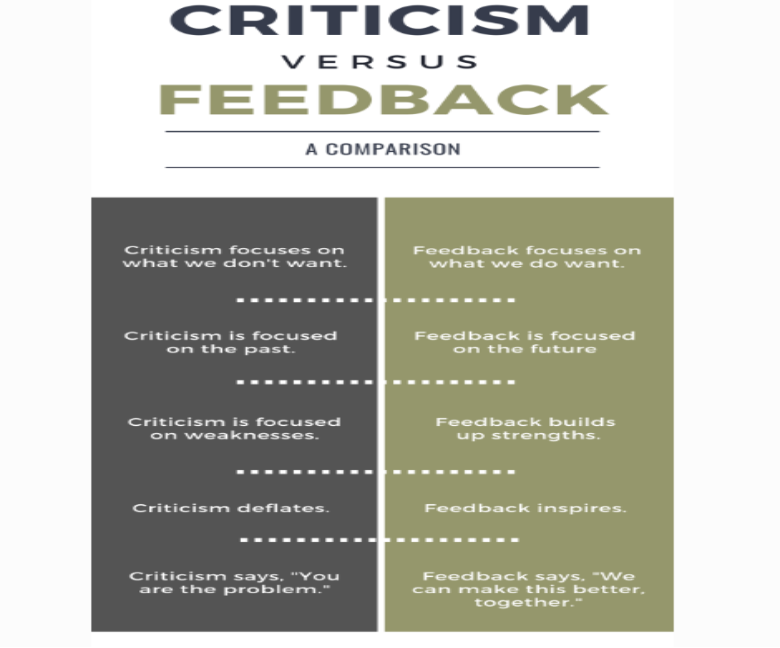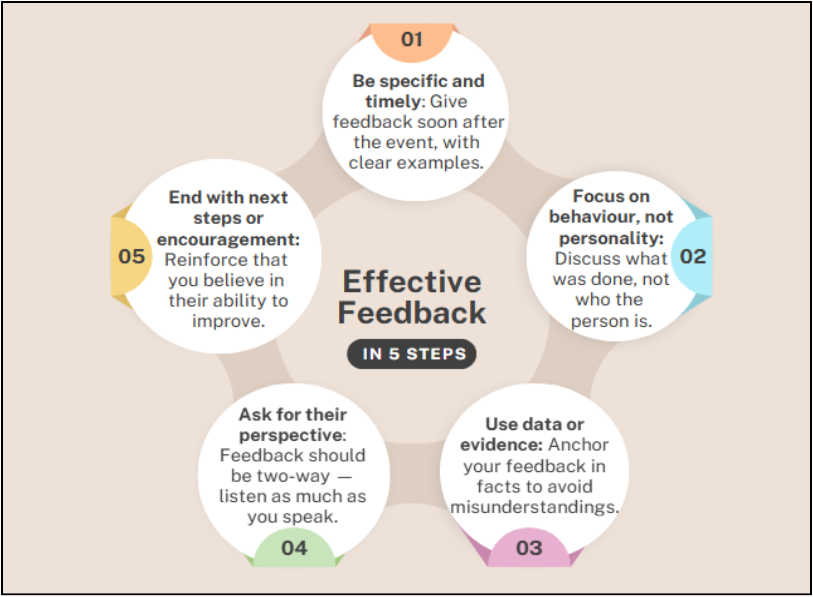Workplace Communication
Types of Feedback: How to Give and Receive It Effectively at Work

.png)
Written by
Aarohi Parakh,
Psychologist and Content Writer

Reviewed by
Sanjana Sivaram,
Psychologist and Clinical Content Head

Types of Feedback: How to Give and Receive It Effectively at Work
Let’s talk about feedback in the workplace. Feedback is an important tool that bridges the gap between performance and progress. It helps individuals grow, learn and adapt to new challenges, and align with the organisation’s goals. It might, however, feel awkward to discuss feedback, especially in the Indian work culture. Employees might worry that it comes across as criticism, or managers might be hesitant to deliver it honestly to avoid causing disharmony.
But here's the good part: when done right, feedback can really boost confidence and motivation. Research even shows that receiving regular feedback can increase engagement by almost 15% and valuable feedback can improve performance by 4.5 times. A continuous feedback mechanism can drive engagement, productivity, and retention at the workplace.
Whether you're an employee looking to level up your game at work or a manager leading your team, understanding the different types of feedback is key to building strong working relationships. This article will also delve into how to give and receive feedback effectively, with real-world workplace examples, making it easier to apply.
What is Feedback and Why It Matters in the Workplace
Feedback is information or input provided to individuals about their performance, behaviour, or actions. To promote personal and professional growth, feedback, at its core, is intended to ‘improve’.

Although feedback and criticism might seem interchangeable, their intent, delivery, and impact differ greatly. While feedback is constructive, specific, and future-oriented, criticism, on the other hand, is judgemental, often vague, and focused on the past. For instance, “the quarterly report missed a few data points regarding customer engagement. Next time, be sure to include these metrics to provide a complete picture” is constructive feedback. Whereas, “your reports are always missing information and you are careless” is personally directed and unhelpful.
The Importance of feedback at the workplace is multi-fold. Regular feedback makes employees feel recognised and appreciated, fosters trust and communication and increases their sense of purpose. This ensures that companies with a strong feedback culture experience higher employee retention and acts as a catalyst for engagement.
Many Indian agile startups and large organisations are focusing on shifting away from traditional annual review cycles (where feedback is provided) to continuous “feedforward” systems. Feedforward is a step up from feedback, where the focus is purely on anticipating employee needs and their future development.
Major Types of Feedback in the Workplace
Understanding the different types of feedback and matching each to its context, can lead to better outcomes for all stakeholders.
Here’s a breakdown of the major types of feedback with examples:
1. Positive Feedback
Definition: It is the act of praising or complimenting someone for their efforts and achievements, which helps to reinforce good behaviour.
Example: “You did an excellent job delivering the project on time. Your strong communication skills and ability to delegate kept us on track”.
Benefits: This helps build motivation, boost morale, and enhance self-confidence. Employees who receive positive feedback are likely also to develop loyalty towards the organisation.
Indian Context: For long, the culture of “what went wrong” has dominated Indian workplaces, rather than the spotlight being taken by “what went right”. But with the advent of hybrid settings and startups, this story is slowly changing.
💡 Pro Tip: Be specific. Instead of just saying “good job”, try saying “your persuasive skills impressed the client”.

2. Constructive Feedback
Definition: It aims to support the individual's learning and development by identifying areas for improvement and offering specific advice. The frameworks that can be adopted are the SBI model (Situation-Behaviour-Impact) or Feedback Sandwich method.
Example: “During yesterday’s meeting (situation), you interrupted twice (behaviour), which made others hesitate to share (impact). Let’s try to give everyone space to contribute next time.”
“I want to compliment you for your dedication to work. However, I have observed some challenges with time management. I believe you can increase your productivity by making a few changes to your time management methods”.
Benefits: It encourages efforts and guides individuals to take action.
💡 Pro Tip: Focus on work, not on the individual’s personality.
3. Negative Feedback
Definition: It focuses on pointing out the mistakes or shortcomings in an individual’s performance or behaviour.
Example: “The report you have submitted has key financial data missing. Let’s ensure we cross-check the figures next time before submission.”
Common Mistakes:
- Delivering it reactively or with clouding of emotions
- Being vague or using judgemental language/tone
- Focussing only on what missed the mark, without providing solutions
- Attacking the person, and not their behaviour
Indian Context: Cultural sensitivity around hierarchy and the norm of “saving face” can make this kind of feedback difficult for managers and employees alike. The key is to aim for balance with openness and empathy. As managers, it is imperative to show understanding and emphasise that the intention is growth, and not punishment.
💡 Pro Tip: Complement negative feedback with actionable steps.

4. Destructive Feedback
Definition: It is the complete opposite of constructive feedback. It is very personal in nature and is unhelpful as it focusses on the individual, and not their work.
Example: “You’re just not good at this.”
Impact: Given it demotivates employees, it can lead to increased staff turnover rates and reduced psychological safety.
How to Avoid It:
- Prepare in advance before giving feedback
- Stay calm and unbiased
- Avoid personal attacks and focus only on facts
💡 Pro Tip: Remember that the goal of feedback is growth, not power dynamics.
5. Formal Feedback
Definition: It is pre-planned, structured, and documented feedback delivered through official channels — such as annual appraisals, HR performance reviews, or 360° evaluations.
Examples: Performance discussions led by HR, Skip-level performance reviews
Impact: This provides consistency and easy access to documentation, especially in large Indian companies and MNCs that use Human Resource Management Systems (HRMS). Platforms like Zoho People, HR One, SAP SuccessFactors, etc. are currently being used across enterprises.
Indian Context: Formal feedback is the most common type ; however, it's increasingly being paired with real-time feedback.
💡 Pro Tip: Combine formal reviews with regular check-ins to encourage consistent two-way dialogue.
6. Informal Feedback
Definition: It is unscheduled, spontaneous, and real-time communication with employees. It can be in the form of a compliment over chai, a quick chat after a meeting, or a message on Teams.
Example: “Nice approach on the ad campaign pitch. It landed well with the client”.
Impact: It helps build a culture of openness where feedback is not feared. Also helps in a higher recall value for both managers and employees.
Indian Context: If leaders normalise frequent informal feedback, it reduces stress during annual review cycles.
💡 Pro Tip: Instead of waiting for formal reviews, recognise efforts when you see it.
7. Developmental vs Evaluative Feedback
Developmental: It is intended to help an employee learn a new skill or advance in their career.
Example: “I see potential in you to develop your leadership skills. Taking on a mentorship role for new team members could help you grow in this area”.
Evaluative: It measures the performance of employees against set goals or standards.
Example: “You have achieved 80% of your sales target for this quarter”.
It should be noted that both are important from an organisational perspective. While developmental feedback focusses on the future potential of the employee, evaluative feedback ensures there is accountability.
💡 Pro Tip: Use developmental feedback for conversations around career growth and promotions, and evaluative feedback for objective assessment.

8. Directional Feedback (Upward, Downward, Peer, and 360°)
Feedback delivery is not limited only to managers and their subordinates. It works in multiple directions within a workplace:
- Upward Feedback: Employees giving feedback to their managers, e.g., “It would be helpful if you can clarify the prioritisation of weekly tasks”.
- Downward Feedback: Managers guiding their team members, e.g., “Your presentation was clear and professional”.
- Peer Feedback: Inputs provided by colleagues or team members rather than supervisors, e.g., “I appreciate your collaborative approach to problem-solving”.
- 360° Feedback: Gathering feedback from multiple sources like supervisors, subordinates, peers, and sometimes even external stakeholders, e.g., “Your direct reports appreciate your supportive leadership style and willingness to delegate work”.
How to Give Effective Feedback
Step-by-Step Process
While the responsibility of delivering feedback rests with managers in most cases, Human Resources (HR) plays a critical advisory role in encouraging feedback throughout the organisation. Below is a step-by-step guide on how to provide effective feedback:

Example: “One of our clients recently shared that it often takes a few days for them to hear back from you. I understand that working with multiple clients can be challenging, but our TAT (Turnaround Time) for responding to customer emails or messages is 1 business day. Is there something we can do to ensure these timelines are met in the future?
Tips for Managers in Indian Workplaces
- Understanding cultural nuances: To respect hierarchy, employees sometimes refrain from voicing their true opinions. Establishing safe spaces where people can express themselves without fear of judgment is essential to fostering trust.
- Leading by example: Managers should not be hesitant to ask for their own feedback. It shows humility and encourages everyone else to speak up too.
- Using empathy: Showing empathy can go a long way in fostering connections with team members. Always appreciate the effort before highlighting areas of improvement.
- Encouraging feedback loops: Making feedback an ongoing and continuous conversation, not a one-time annual event, is the key to effectiveness.
- Integrating it into systems: Linking regular feedback into HRMS/performance management systems and employee wellness initiatives would lead to the rounded development of employees.
Common Challenges in Giving or Receiving Feedback
Despite its importance, feedback can often land wrong because of human and cultural barriers.
- Fear of offending others: In many Indian workplaces, politeness and respect can prevent people from being honest. Managers worry about upsetting their teams, while employees hesitate to give feedback to their superiors.
- Hierarchy and miscommunication: Feedback may get watered down or lost due to strict organisational structures. Lower-ranking employees may often feel reluctant to question their seniors.
- Lack of training: Not everyone knows how to deliver feedback helpfully. Without guidance and training, it may come across as too harsh or too vague.
- Resistance or defensiveness: Some employees can see feedback as criticism, which can lead to denial or emotional outbursts. Neither of these responses supports the individual's growth.

Employee Assistance Programmes (EAPs) and counselling services can play a key role in developing these soft skills. For example, 1to1help’s manager development modules teach leaders to use empathy, emotional regulation, and active listening during feedback conversations.
Benefits of a Feedback Culture
Managers and HR teams play a central role in cultivating a feedback culture. Building a feedback culture means making open and honest communication a daily practice, not just an annual event.
- Higher Performance and Engagement: Employees who get regular feedback are more aware of their strengths and areas to improve. Gallup research shows that workers who receive meaningful feedback weekly are 3.6 times more engaged than those who do not.
- Stronger Relationships: Constructive feedback builds trust and respect between managers and employees. When people feel heard and supported, teamwork improves naturally.
- Continuous Improvement: Regular feedback encourages learning and adaptability, which are essential qualities in fast-changing industries like IT, healthcare, and education.
- Reduced Attrition and Burnout: When employees see how their work fits into the bigger picture, they feel more valued and less disconnected. A good feedback culture can significantly lower turnover and improve mental well-being.
With changing times, Indian companies are experimenting with regular feedback/feed-forward sessions to normalise growth conversations.
FAQs
Q1. What are the main types of feedback in the workplace?
Positive, constructive, negative, destructive, formal, informal, developmental, evaluative, and directional feedback are among the main forms of feedback, each with various functions. Good performance is reinforced by positive feedback, whereas skills or behaviour are improved through constructive feedback. The structure of formal and informal feedback varies, and the person providing or receiving the feedback determines its direction. A combination of these kinds contributes to a well-rounded, development-focussed workplace culture.
Q2. How is constructive feedback different from negative feedback?
Constructive feedback focusses on improvement and is given with empathy, clarity, and specific suggestions. It aims for solutions and supports learning. In contrast, negative feedback points out mistakes without providing clear direction. When not handled carefully, it can discourage or demotivate employees. The main difference lies in tone and intent; constructive feedback builds confidence, while negative feedback often undermines it.
Q3. What is 360-degree feedback?
360-degree feedback is a comprehensive performance review in which managers, peers, subordinates, and, occasionally, clients provide input to employees. It encourages self-awareness and accountability by providing a comprehensive view of an employee's strengths and growth areas. Many organisations use it in leadership and development programmes.
Q4. How can managers handle employees who resist feedback?
First, remain composed and listen to what they have to say. Describe how feedback is meant to be used for improvement rather than criticism. Give concrete examples, concentrate on behaviour rather than personality, and work with others to establish modest but attainable goals. Over time, this strategy fosters trust and lessens defensiveness.
Q5. What role does feedback play in performance appraisals?
The foundation of impartial and open evaluations is feedback. It assists in monitoring development, acknowledging successes, and identifying areas for improvement. Constant feedback all year long guarantees that appraisals are more forward-looking, balanced, and development-focussed rather than evaluation-only.
Final Thoughts
Feedback serves as both a means of promoting personal development and a performance tool. When managed carefully, it improves morale, fosters learning, and fortifies bonds. Any feedback, whether constructive or positive, formal or informal, can impact someone's confidence and career.
Feedback will remain essential to professional development as Indian workplaces shift from hierarchical to more collaborative cultures.
If you're a manager or HR leader, consider how 1to1help's leadership and emotional wellness programs can improve your team’s ability to provide and receive feedback with clarity and empathy.
After all, one honest discussion is all it takes to kick-start your growth journey.
References
- Amber Johnson & Jim Ludema. (2019, November 7). Criticism vs. feedback. Forbes. https://www.forbes.com/sites/amberjohnson-jimludema/2019/11/07/criticism-vs-feedback/
- Center for Creative Leadership (CCL). (n.d.). Closing the gap between intent vs. impact (SBII). https://www.ccl.org/articles/leading-effectively-articles/closing-the-gap-between-intent-vs-impact-sbii/
- Gallup. (n.d.). Fast feedback fuels performance. https://www.gallup.com/workplace/357764/fast-feedback-fuels-performance.aspx
- Economic Times. (n.d.). Definition of attrition. https://economictimes.indiatimes.com/definition/attrition
- Psychology Today. (n.d.). Burnout. https://www.psychologytoday.com/us/basics/burnout
- American Psychological Association (APA). (n.d.). Psychological safety at work. https://www.apa.org/topics/healthy-workplaces/psychological-safety
- Indeed. (n.d.). How to use the sandwich feedback method. https://au.indeed.com/career-advice/career-development/sandwich-feedback
- Federation University. (n.d.). Types of feedback. https://federation.edu.au/staff/learning-and-teaching/teaching-practice/feedback/types-of-feedback
- NSW Department of Education. (n.d.). Types of feedback to students. https://education.nsw.gov.au/teaching-and-learning/professional-learning/teacher-quality-and-accreditation/strong-start-great-teachers/refining-practice/feedback-to-students/types-of-feedback
- Personio. (n.d.). Types of feedback. https://www.personio.com/hr-lexicon/types-of-feedback/
- Supahub. (n.d.). Types of feedback. https://supahub.com/blog/types-of-feedback
- AIHR. (n.d.). Types of feedback: 10 examples to improve performance. https://www.aihr.com/blog/types-of-feedback/
- Awork. (n.d.). Feedback – Definition and examples. https://www.awork.com/glossary/feedback
- Valamis. (n.d.). Types of feedback: Meaning, examples, and benefits. https://www.valamis.com/hub/types-of-feedback
- Staffbase. (n.d.). Employee feedback examples. https://staffbase.com/blog/employee-feedback-examples
- Market.biz. (n.d.). Employee feedback statistics (Editor’s choice). https://market.biz/employee-feedback-statistics/#editors-choice
- The Economic Times. (2023, October 26). Feedback is a thing of the past; feedforward to now lead employees and organisations. https://economictimes.indiatimes.com/jobs/hr-policies-trends/feedback-is-a-thing-of-past-feedforward-to-now-lead-employees-and-organisations/articleshow/104813364.cms










